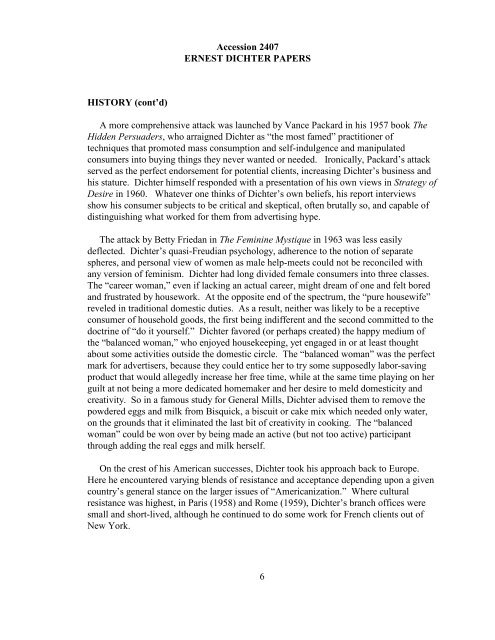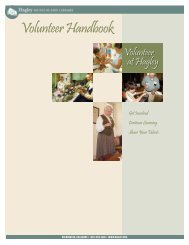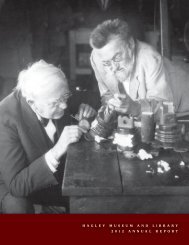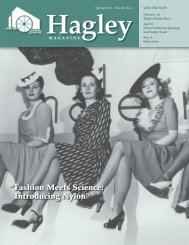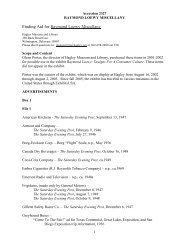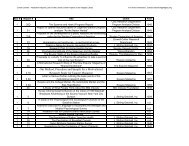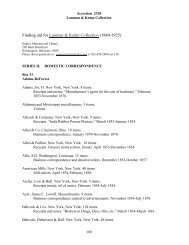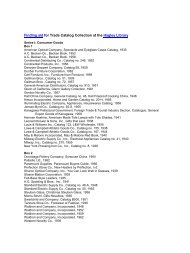Ernest Dichter Papers - Hagley Museum and Library
Ernest Dichter Papers - Hagley Museum and Library
Ernest Dichter Papers - Hagley Museum and Library
Create successful ePaper yourself
Turn your PDF publications into a flip-book with our unique Google optimized e-Paper software.
HISTORY (cont’d)<br />
Accession 2407<br />
ERNEST DICHTER PAPERS<br />
A more comprehensive attack was launched by Vance Packard in his 1957 book The<br />
Hidden Persuaders, who arraigned <strong>Dichter</strong> as “the most famed” practitioner of<br />
techniques that promoted mass consumption <strong>and</strong> self-indulgence <strong>and</strong> manipulated<br />
consumers into buying things they never wanted or needed. Ironically, Packard’s attack<br />
served as the perfect endorsement for potential clients, increasing <strong>Dichter</strong>’s business <strong>and</strong><br />
his stature. <strong>Dichter</strong> himself responded with a presentation of his own views in Strategy of<br />
Desire in 1960. Whatever one thinks of <strong>Dichter</strong>’s own beliefs, his report interviews<br />
show his consumer subjects to be critical <strong>and</strong> skeptical, often brutally so, <strong>and</strong> capable of<br />
distinguishing what worked for them from advertising hype.<br />
The attack by Betty Friedan in The Feminine Mystique in 1963 was less easily<br />
deflected. <strong>Dichter</strong>’s quasi-Freudian psychology, adherence to the notion of separate<br />
spheres, <strong>and</strong> personal view of women as male help-meets could not be reconciled with<br />
any version of feminism. <strong>Dichter</strong> had long divided female consumers into three classes.<br />
The “career woman,” even if lacking an actual career, might dream of one <strong>and</strong> felt bored<br />
<strong>and</strong> frustrated by housework. At the opposite end of the spectrum, the “pure housewife”<br />
reveled in traditional domestic duties. As a result, neither was likely to be a receptive<br />
consumer of household goods, the first being indifferent <strong>and</strong> the second committed to the<br />
doctrine of “do it yourself.” <strong>Dichter</strong> favored (or perhaps created) the happy medium of<br />
the “balanced woman,” who enjoyed housekeeping, yet engaged in or at least thought<br />
about some activities outside the domestic circle. The “balanced woman” was the perfect<br />
mark for advertisers, because they could entice her to try some supposedly labor-saving<br />
product that would allegedly increase her free time, while at the same time playing on her<br />
guilt at not being a more dedicated homemaker <strong>and</strong> her desire to meld domesticity <strong>and</strong><br />
creativity. So in a famous study for General Mills, <strong>Dichter</strong> advised them to remove the<br />
powdered eggs <strong>and</strong> milk from Bisquick, a biscuit or cake mix which needed only water,<br />
on the grounds that it eliminated the last bit of creativity in cooking. The “balanced<br />
woman” could be won over by being made an active (but not too active) participant<br />
through adding the real eggs <strong>and</strong> milk herself.<br />
On the crest of his American successes, <strong>Dichter</strong> took his approach back to Europe.<br />
Here he encountered varying blends of resistance <strong>and</strong> acceptance depending upon a given<br />
country’s general stance on the larger issues of “Americanization.” Where cultural<br />
resistance was highest, in Paris (1958) <strong>and</strong> Rome (1959), <strong>Dichter</strong>’s branch offices were<br />
small <strong>and</strong> short-lived, although he continued to do some work for French clients out of<br />
New York.<br />
6


